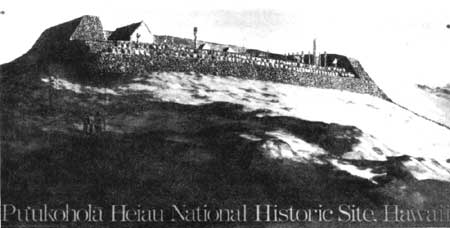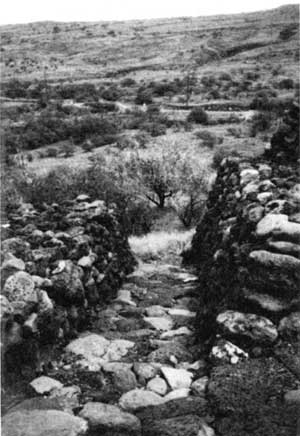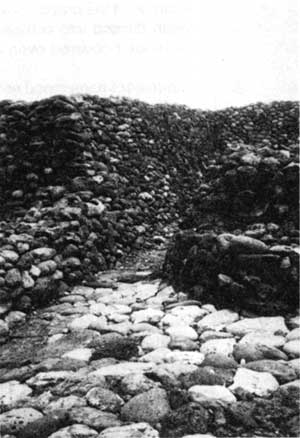PU'UHONUA O HONAUNAU NHP
A Cultural History of Three Traditional Hawaiian Sites
on the West Coast of Hawai'i Island

|
PU'UKOHOLA HEIAU NHS • KALOKO-HONOKOHAU NHP • PU'UHONUA O HONAUNAU NHP A Cultural History of Three Traditional Hawaiian Sites on the West Coast of Hawai'i Island |

|
|
Site Histories, Resource Descriptions, and Management Recommendations |
CHAPTER VII:
PU'UKOHOLA HEIAU NATIONAL HISTORIC SITE (continued)
N. Management Recommendations (continued)
1. Analysis of Pu'ukohola Heiau (continued)
g) Variability of Heiau Styles
A number of possibilities exist for placement of structures on Pu'ukohola Heiau. Variables relate to the number, type, and arrangement of structures and houses on the platforms; the location of idols and the altar; and the presence of fences or interior walls. This writer believes so many possibilities exist relative to the original appearance of the temple that at best only a conjectural restoration would be possible.
As many authorities have pointed out, probably no two heiau in the Hawaiian Islands were exactly alike. Kamehameha, a very powerful chief on his way to becoming ruler of all the islands, might have believed that some aspects of temple construction were flexible. On the other hand, because he remained basically faithful to the ancient religion, he probably followed many of the traditional religious dictates. As Reverend Gowen stated relative to the construction and consecration of Pu'ukohola, "We may be certain that whatever elements of impressiveness Kamehameha could impart were there. At the same time there were some special features of which we are at present ignorant." [273] Although there were certain basic structures that were placed on this type of heiau, they were not always placed in the same position relative to each other, although there were certain prescribed rules set by traditional ritual dictating the various structures' relationship to each other and to other structures on the platform. How closely Kamehameha adhered to these rules is not known. He might have changed configurations of structures or added or deleted items for his own reasons; he probably would not have altered things arbitrarily.
 |
| Illustration 85. Conjectural 1916 drawing under the direction of J.F.G. Stokes of Pu'ukohola Heiau's appearance ca. 1800. This shows two large structures on the north edge of the northern platform area with a smaller shelter perpendicular to them toward the middle of the platform. Images and the oracle tower are located on the south end. Courtesy Bernice P. Bishop Museum, Honolulu. |
 |
| Illustration 86. Conjectural drawing of appearance of Pu'ukohola Heiau as a functioning luakini by the Hawaiian artist Herb Kawainui Kane, 1978. NPS photo. |
h) Known Features of Pu'ukohola Heiau
There are a number of details relative to Pu'ukohola's original appearance that can be substantiated both from the historical accounts and from surface surveys, although no in-depth archaeological study providing definitive on-site evidence has been accomplished:
the entrance to the platform was at the northwest corner of the structure, presumably the present opening
the large temple platform area was enclosed on the east side and the north and south ends by high walls
there are suggestions of a low wall on the seaward side and possibly a wooden fence stretched north-south along the top terrace delineating the platform's sacred boundaries — wooden fences were often used in conjunction with stone walls and were often an integral part of the heiau structure — this one probably was about four feet high with human skulls affixed to the wooden pales [274]
the large platform on the north end of the courtyard probably held at least three structures
the pavement area south of the northern platform was the area of offerings — there appear to have been two pits inside the temple, one near the principal altar, the other close to the northern platform
south of this large pavement area was another platform, possibly the location of the oracle tower and several images — this might originally have been divided into compartments, or cells, as Samuel Hill described, that were later covered over, as Cluff suggests
the major image stood either in the southeast corner or in the center of the southern platform with possibly another one near the center of the northern platform — lesser images were arranged in the lower southern platform section either facing the major image in the southeast corner or facing toward the altar and the large pavement area on either side of the major image — there were probably additional images in front of the hale mana and on each side of the hale wai'ea — in addition there could have been a guardian image in the niche at the entrance and other images arranged along the top of the wall surrounding the platform, in niches around the walls, and on the terraces — it is unclear whether these large images were on the heiau walls from the beginning, because only skulls are mentioned in the earliest accounts — however, wooden images seem to have been an integral part of the dedication of a luakini — in terms of style, the fixed images throughout the temple would have been a mixture — some carved on poles, others in the round, others carved on slabs
originally skulls were displayed on a wooden railing described as being either on top of the temple walls, at the east edge of the first terrace, or on the roof of a structure — this writer tends toward the hypothesis that there was a wooden fence in front of the sacred area on the first terrace as Stokes indicates in his drawing and that the skulls were displayed on it, as was done on other heiau (according to Valeri, the skulls of sacrificial victims were put on a paehumu pole because, as the most important part of the body, they stayed in the temple with the gods) [275]
the terraces comprised a series of platforms that, due to the slope of the hill, were necessary to keep the top platform area level — this writer questions whether those with permission to attend the rituals sat on these because of their size, the awkwardness of getting on and off them, and because they appear to have had images placed on them (according to Thrum, in some instances at least, commoners not allowed in the temple itself could watch the rites from the tops of nearby hills). [276]
Pu'ukohola's rites may have been too important to allow commoners to watch them. The stone wing walls extending from the northwest and southwest corners of the temple probably marked the limits of the temple's sacred space. Just as the enclosure on the platform marked the sacred boundaries of the "inner temple," these walls would have marked the area outside the temple kapu to women and possibly commoners. [277] Therefore, there would have been no opportunity for individuals other than those participating in the rites to watch the ceremonies from the area toward the beach.
 |
 |
| Illustration 87. Entrance to Pu'ukohola Heiau at the northwest corner of the structure. NPS photo, 1989. | Illustration 88. Raised platform at north end of temple area, walkway on north edge circling around along the east wall, and paved platform area in front (west edge). NPS photo, 1989. |
One or two aspects of Pu'ukohola Heiau are unusual. One is the entrance, which seems to be a unique feature of this heiau. Usually the terraces of these structures were made to ascend or descend and functioned as the entrances to the platform area. At Pu'ukohola they are too massive and high to serve as steps; therefore the need for another entrance. As discussed in the section above, the location of the oracle tower is a puzzle. Ellis's description of the oracle tower on the south end and the statement by archeologists that the northern platform seems better finished, as if for a housing area, both indicate that the 'anu'u stood at the south end. Valerio offers some interesting explanations for its not being in the northern part of the temple as Malo directs. Again, intensive archeological work might help clarify its location.
| <<< Previous | <<< Contents >>> | Next >>> |